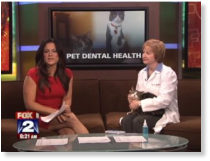Dental care for cats
According to the American Veterinary Dental Society, 70% of
cats show signs
of dental disease by age 3. Just like
humans, cats experience tooth decay,
bleeding gums and tooth
loss. In serious cases, bacteria travel through the
bloodstream and cause heart, lung, liver and kidney damage.
Any of the following may be symptoms of dental disease in
your cat:
-
Noticeable pain when you touch his/her mouth or face.
-
Bad breath (halitosis) which could signal a build-up of bacteria.
-
Redness or bleeding around the gums.
-
Swelling in the face or mouth area.
-
Excessive drooling from the mouth.
Some cat breeds are more prone to dental disease than others, including Balinese, Burmese, Exotic Short/Long Hair, Himalayan, Orange mixed breed and purebred, Oriental Short/Long Hair, Persian, Siamese and Tonkinese. See more on specific CAT BREEDS and which are more prone to dental disease and other serious health conditions.
Your cat’s teeth should be examined twice annually as part of his/her regular bi-annual physical. Your veterinarian will look carefully for any symptoms as well as for broken, loose or decayed teeth and tartar build up. If any of these are present, your veterinarian will most likely recommend a DENTAL CLEANING to remove excessive tartar. A DENTAL X-RAY may also be recommended, to pinpoint any root or nerve damage. Both of these are done under anesthesia while your kitty is being carefully monitored.
![]() Taking care of those purr-ly whites. Watch our video:
Taking care of those purr-ly whites. Watch our video:
 Easy steps for brushing your cat’s teeth.
Easy steps for brushing your cat’s teeth.
Click on the link above or scan the QR code with your smartphone to watch the video!
What can you do to provide dental care at home? Try brushing your cat’s teeth at least weekly – or applying oral gels. Read What every Feline Family should know: Teeth cleaning is essential to preventing dental disease.



